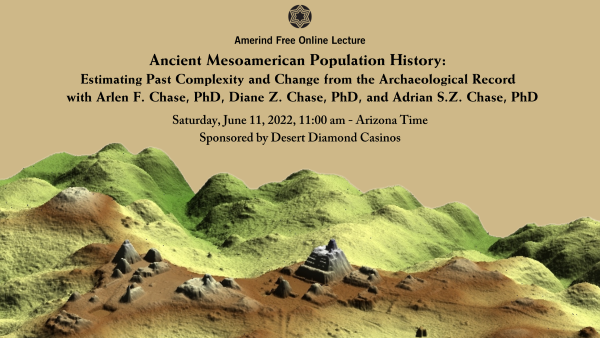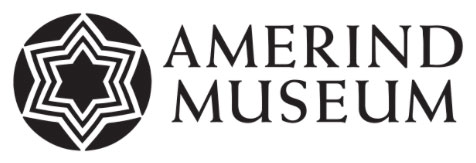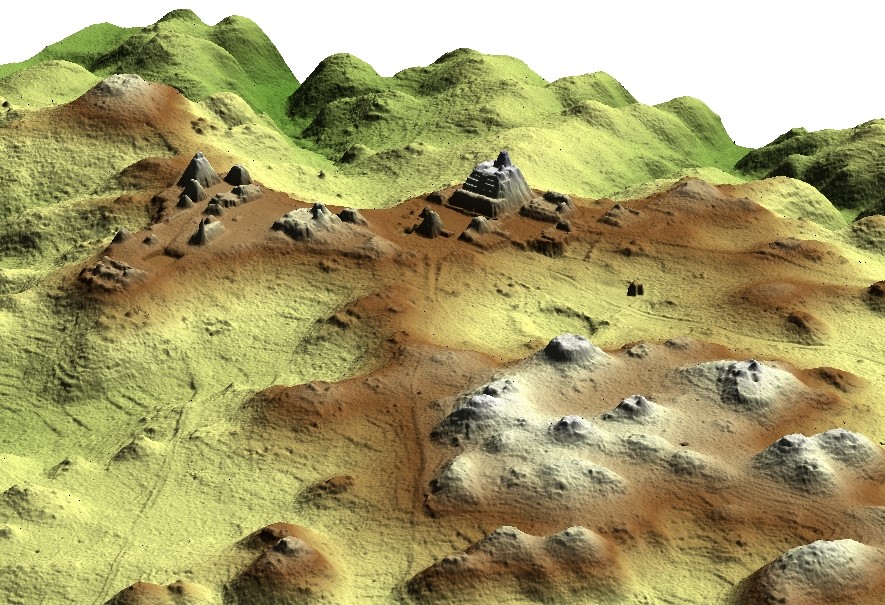
Amerind Free Online Lecture
Ancient Mesoamerican Population History: Estimating Past Complexity and Change from the Archaeological Record with Arlen F. Chase, PhD, Diane Z. Chase, PhD, and Adrian S.Z. Chase, PhD
Saturday, June 11, 2022, 11:00 am – Arizona Time
Sponsored by Desert Diamond Casinos
Determining how many people lived in ancient cities is key to making interpretations about their ancient lifeways; it is also important for understanding how societies adapted to their local environments, changed over time, and distributed themselves across space. However, identifying population numbers in the archaeological record is not a simple task, especially without data like modern census numbers. Mesoamericanists use several techniques to derive population estimates and these vary depending upon research area. In the highlands of Mesoamerica, population numbers are usually determined from surface surveys and estimations of hectares of land that were once occupied. In the lowlands, estimations are often based on numbers of mapped mounds and an extrapolation of occupants per mound and area occupied. In both areas, change over time is often based on the dating of broken pottery recovered through archaeological testing. Yet, the use of different methodologies has led to divergent interpretations about the sizes of ancient Mesoamerican populations and the density of settlement. Especially in the Maya area, the use of new technologies, such as lidar (light detection and ranging), has helped to define the limits of centers and their settlement; this is leading to a renaissance in spatial research on Maya populations. How population estimates are determined has further implications for interpreting urbanism and socio-political complexity throughout Mesoamerica. The results of a recent Amerind session on ancient Mesoamerica population history – that sought to examine and strengthen past approaches to population estimation and changes over time and to develop new options for approaching ancient population histories – are reported here.
Arlen F. Chase has been engaged in Maya archaeology since 1971. He earned his BA in 1975 and then his PhD in Anthropology in 1983 from the University of Pennsylvania on archaeological excavations carried out at Tayasal, Peten, Guatemala. Since 1978, he has been actively involved in archaeological excavation in Belize. With his wife, Diane Z. Chase, he has directed research at the sites of Nohmul (1978-1979), Santa Rita Corozal (1979-1985), and Caracol (1985-present). His academic career has included positions at three universities: the University of Central Florida from 1984 through 2016, where he was named as a Pegasus Professor (in 2007) and also held various administrative roles; the University of Nevada, Las Vegas from 2016 through 2019 where he served as Professor of Anthropology; and, Pomona College in Claremont, California where he has been a member of the Anthropology Department since 2019. His publications are available for download at http://www.caracol.org.
Diane Z. Chase earned her BA in 1975 and then her PhD in Anthropology in 1982 from the University of Pennsylvania on archaeological excavations she directed at Nohmul and Santa Rita Corozal, Belize. With her husband, Arlen F. Chase, she has co-directed archaeological research at the sites of Nohmul (1978-1979), Santa Rita Corozal (1979-1985), and Caracol (1985-present). Her academic career has included positions at four universities: Princeton University from 1983 through 1984, where she served as a lecturer; the University of Central Florida from 1984 through 2016, where she was named as a Pegasus Professor (in 2003) and also held various university roles; the University of Nevada, Las Vegas from 2016 through 2019 where she served as Executive Vice President and Provost; and Claremont Graduate University in Claremont, California since 2019 where she serves as Vice President for Academic Innovation, Student Success, and Strategic Initiatives. Her publications are available for download at http://www.caracol.org.
Adrian S.Z. Chase is currently a Research Fellow at Claremont Graduate University. He spent at least two months of each of his formative years at the archaeological field camp of Caracol, Belize. He obtained degrees in Archaeology and Computer Science at Harvard, writing a senior thesis on ancient Maya reservoirs and water management using lidar. He continued exploring lidar and ancient urbanism in his MA and dissertation research at Arizona State University, graduating with a Ph.D. in Anthropology from the School of Human Evolution and Social Change in 2021. In August 2022, he will begin a 2-year Post-Doctoral position at the University of Chicago in the Anthropology Department and the Mansueto Institute for Urban Innovation. Besides excavating at Caracol, he has also carried out field work at Hirbemerdon Tepe in Turkey and at Chichen Itza and Teotihuacan in Mexico. His publications are available for download at http://www.caracol.org.
To register, visit: https://bit.ly/AmerindOnline061122

